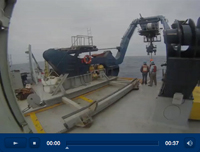
 Today's Weather
Today's Weather
Cloudy
Lat: 28d 40’ N
Long: 88d 29’ W
Air temp: 54.1F (12.3C)
Water temp: 74.5F (23.6C)
Barometric pressure: 1019 mbar
Seas: 2-3 feet
Wind: NE, 15.4 mph


Related link:
Tracking the Oil Spill
in the Gulf
New York Times interactive
Waiting, Working, and Wondering
December 08, 2010 (posted December 9, 2010)
by Ken Kostel
It takes phenomenal effort to organize and execute a research cruise like this. But when Alvin goes in the water, things take on a decidedly different rhythm and intensity.
Everything begins well before 7:30 a.m. when Alvin generally rolls out of its hangar on deck. Pilots and scientists meet to finalize the plan they will pursue once they reach the bottom and to organize the equipment in Alvin’s basket. Things have to be placed in particular positions for the pilot to be able to reach core samplers or sample jars at the right time during the dive.
Once all the preparations are complete, all 35,000 pounds of Alvin rolls slowly out onto the fantail of Atlantis, the pilot and observers climb in, and the sub gets hoisted out over the stern under the ship’s massive A-frame. Once the support divers have completed their pre-dive checks and made sure the sub is secured, Alvin receives clearance to dive and it begins the long, slow descent to the seafloor. It will be an hour before anyone inside sees the bottom at 1,400 meters. Then they have to drive to where they think something interesting will be.
Today, Chuck Fisher (the chief scientist) and Mike de Gruy (a filmmaker) were aiming for a patch of corals that the remotely operated vehicle Jason found in November, which appeared to be dead or dying and covered in a brown film. That’s one tiny patch of deep-sea corals in the dark depths of the Gulf of Mexico.
They found it almost immediately, a testament to the pre-dive planning and input by everyone involved, including the Sentry team early this morning, and in particular by Walter Cho and Pen-Yuan Hsing, who produced seafloor maps that gave Alvin pilot Dave Walter nearly turn-by-turn directions to find specific clusters of corals.
While Mike and Chuck began their visual survey and sample collecting below, those of us on the ship suddenly found ourselves with little to do—until we realized that the cruise had simply forced us to put off many other tasks. Everywhere around the ship there were little groups of people writing, studying, or (in the case of the ever-busy Atlantis crew) repairing and cleaning the ship.
Then it was afternoon, and word went around that Alvin was on its way back. Things shifted gears yet again as everyone began preparing for the sub’s return. Atlantis and Alvin crews got ready to retrieve and secure the sub; the science crew began to organize for the inevitable flood of samples from the seafloor.
When the sub reached 400 meters, the Avon—Atlantis’ small boat—went out with two divers into the choppy Gulf waters. The sub surfaced 700 meters in front of the ship and the divers secured a towline to the outside. Once positioned behind Atlantis, the divers attached Alvin to the A-frame and the sub was hoisted back to the fantail.
After Alvin was safely back in its hangar, everyone with a sample to retrieve clustered around the basket. Pilots and Alvin support crew clustered to one side, reviewing the dive. Little by little, everyone filtered inside and dispersed to labs and meeting areas.
Now the long-term work of the cruise begins—making sense of the samples and the data. And it all begins again tomorrow.
[ Previous update ] [ Next update ]
[Back
to top] |



